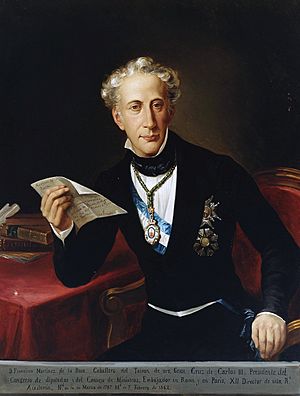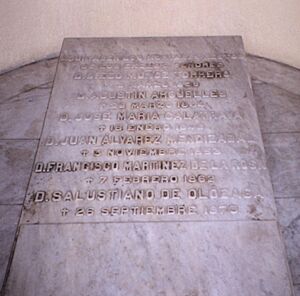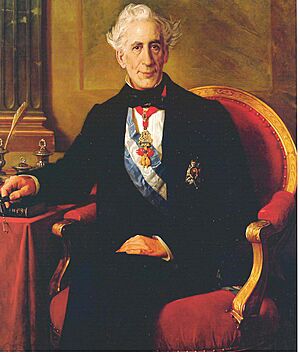Francisco Martínez de la Rosa facts for kids
Quick facts for kids
The Most Excellent
Francisco Martínez de la Rosa
|
|
|---|---|
 |
|
| Prime Minister of Spain | |
| In office January 10, 1834 – June 7, 1835 |
|
| Monarch | Isabella II |
| Preceded by | Francisco Cea Bermúdez |
| Succeeded by | José María Queipo de Llano |
| In office February 28, 1822 – August 5, 1822 |
|
| Monarch | Ferdinand VII |
| Preceded by | Ramón López Pelegrín (acting) |
| Succeeded by | Evaristo Fernández San Miguel y Valledor (acting) |
| Personal details | |
| Born | March 10, 1787 Granada, Spain |
| Died | February 7, 1862 (aged 74) Madrid |
| Resting place | Pantheon of Illustrious Men |
| Political party | Realista Moderado |
| Alma mater | University of Granada |
| Signature | |

Francisco de Paula Martínez de la Rosa y Cornejo (born March 10, 1787 – died February 7, 1862) was an important Spanish politician and writer. He was the very first person in Spain to be called the "President of the Council of Ministers," which is like being the prime minister today.
Contents
A Life in Politics and Literature
Francisco Martínez de la Rosa was born in Granada, Spain. He received his education at the university in his hometown.
Early Career and Exile
He first became popular for his clever short poems. These were published under the title El Cementerio de momo. During the time Spain was fighting against Napoleon, Francisco chose the patriotic side.
He was elected as a deputy, which is like a representative in government. While in Cadiz, he wrote his first play, Lo que puede un empleo. This was a comedy written in prose.
Later, in 1814, he was sent away to Peñón de Vélez de la Gomera. This place is on the Barbary Coast. He stayed there until 1820.
Return to Power and Challenges
In 1820, Francisco was suddenly called back to Spain. He was then appointed as prime minister. For the next three years, he faced many challenges.
He was not very popular during this time. Some people called him a revolutionary, while others called him a reactionary. This meant he didn't have strong support from any group. He even earned the nickname "Rosita la Pastelera," which meant "Rosie the compromiser."
Exile in Paris and Literary Works
In 1823, he was sent into exile again. This time, he went to Paris. While in Paris, he published his Obras literarias (Literary Works) in 1827.
This collection included his Arte poética, which discussed his ideas about poetry. He was influenced by the new ideas of the French Romantic Movement. He even wrote a romantic play in French called Abén Humeya.
Later Political Roles
Francisco returned to Spain in 1831. After the death of Ferdinand VII, he became prime minister once more. However, he found it difficult to handle the rebellions happening in the country.
He resigned from his position in 1834. Before he left office, Martínez de la Rosa approved an important royal decree. This decree officially ended the Spanish Inquisition, a powerful religious court.
He served as an ambassador in Paris from 1839 to 1840. He was also an ambassador in Rome from 1842 to 1843. He later joined the Conservative party.
Francisco held many important government jobs. He was the president of the Spanish congress. He was also the director of the Spanish academy when he passed away. He died in Madrid on February 7, 1862.
Influence on Spanish Drama
Even though his political career had its ups and downs, his literary work was very important. His early plays and poems were influenced by other Spanish writers. His historical novel, Doña Isabel de Solís, was inspired by the works of Walter Scott.
Because he lived in Paris during his exile, he met many leaders of the French Romantic Movement. This experience greatly influenced his writing. When he returned to Madrid, he produced La Conjuracíon de Venecia in 1834. This play is considered a very important work. It made him a pioneer, or a leader, of romantic drama in Spain.
See also
 In Spanish: Francisco Martínez de la Rosa para niños
In Spanish: Francisco Martínez de la Rosa para niños


